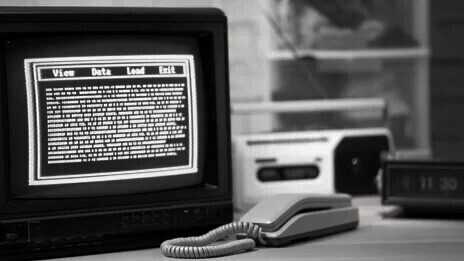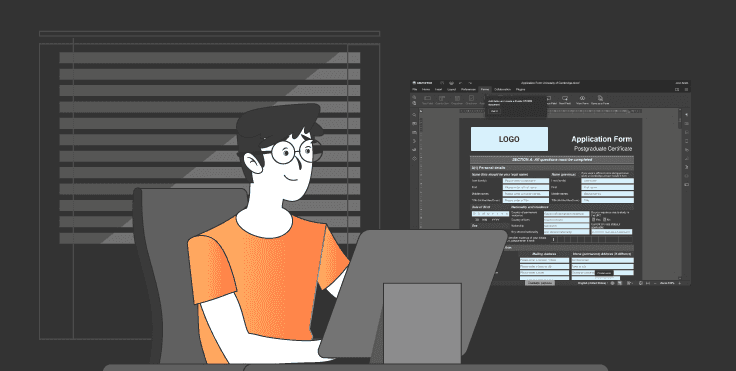Reducing the ecological footprint while improving accessibility: the winning combination of dark mode
Lights out! The interface of many web platforms and mobile applications now offer the option of being displayed in "dark mode": light text or interface components on a dark canvas. Presented as a design trend, a response to a desire for personalization or a feature offering improved reading comfort, is dark mode just a passing fad?
Not something to be wished for, as dark mode could be more virtuous and useful than it seems. In fact, it has a largely underestimated and little-mentioned potential that echoes the challenges of our time. First of all, it reduces the environmental impact of digital technology through its ability to save the energy produced by the digital services and equipment we use every day. But also that of improving interface accessibility, and thus contributing to digital inclusion. A look back at "dark mode" with a perspective from our Chief eXperience Officer, Franck Valadier.

A look back at the history of "dark mode 📜
To put things into context, let's look at the origins of dark mode, which in truth is nothing new! In fact, the history of computers, the first digital media with which we interacted, began with dark mode, the only option available at the time for cathode-ray screens.
The situation began to change when the first consumer computers with color screens appeared. In the '80s, the advent of backlit screens and LCD monitors enabled a white background to be displayed instead of the usual black. The aim of these new interfaces was to reproduce a virtual version of a work desk, and thus obtain a screen reminiscent of the whiteness of a notebook.
Today, digital interfaces are breaking out of this straitjacket to sail towards new horizons, and social networks have been the first to move in this direction in recent years. At the intersection of user experience, energy consumption and ease of reading, dark mode paves the way for an interface that responds to our current concerns.
Is dark mode really useful in saving energy and reducing the digital footprint? 🌎
Activating dark mode can be a simple measure to save energy and thus reduce the ecological footprint linked to our daily use of digital equipment. However, it's essential to stress that the real impact of dark mode on the ecological footprint depends on several factors,.
The use of "dark mode" can only have a tangible impact on energy consumption if the phone has an OLED screen. LCD screens are based on backlighting, so they are constantly on, whether the phone is in light or dark mode. Conversely, an OLED screen emits its own light to display content: in dark mode, the black pixels are essentially switched off, reducing the screen's energy consumption. Given that the screen is one of the main energy consumers on a phone, and that OLED technology is widely used, using dark mode can extend the life of equipment by reducing the frequency of recharging.
Although these positive effects may not apply to computer screens (which are predominantly LED), dark-mode web applications and browsers are now legion and offer advantages other than energy savings, such as the one essential to Responsible Digital: digital accessibility.

Beyond reading comfort: digital accessibility in question 🤝
Many users say they appreciate dark mode above all else, as it offers them greater reading comfort through its softer, less aggressive light than light mode. Although the harmful effect of dark mode has also been raised as a potential problem, the resulting eye strain is attributed more to excessive interaction with screens than to any particular light mode, according to Euna Koo of Stanford's Byers Eye Institute.
Dark mode is a little-mentioned yet crucial feature in terms of digital inclusion, and can help improve** digital accessibility** for the visually impaired. Here's how dark mode can help:
- Enhanced contrast: The use of dark colors for the background and light colors for text and interface elements creates greater contrast. For people with certain forms of visual impairment, this facilitates legibility and makes it easier to distinguish between different elements on the screen.
- Reduced glare: People with light sensitivity (photophobia) may find the dark mode more comfortable, as it reduces the glare caused by bright screens.
- Adaptability: For some users with impaired vision, using the dark mode may be a personal preference: the ability to customize the interface's appearance in this way can contribute to a user experience better adapted to their visual needs.
An interface option tailored to responsible digital projects
The fruggr website also offers access to different brightness and color modes, to make it easier to read for all audiences. We also recommend a "dark mode" option to our customers, particularly for eco-design projects: this dark mode goes hand in hand with a desire for frugality in all aspects of the digital platform: image weight, choice of hosting, quantity of data, and so on.
Even major groups like L'Oréal have adopted this interface option in a project that combines sobriety and digital inclusion: that of its 2022 annual report. Offering an optimal browsing experience, accessible to all and with a minimal footprint, the report's site meets RGAA requirements and includes a "low power" mode.
In short, dark mode is a relevant element that can be integrated into a digital optimization strategy to meet accessibility and reduced environmental impact objectives.
\
The expert's angle: A word from Franck Valadier, Chief eXperience Officer
Dark mode, eco mode, the key words are reduce and include.
Reducing the carbon footprint, in particular by cutting energy consumption, but also by reducing the quantity and weight of displayed elements. It's with this in mind that dark mode is evolving towards eco-mode, not only ensuring that brightness is reduced, but also switching to more frugal browsing. In the same way, and to meet the challenges of inclusion and accessibility, none of these modes should be imposed, since the comfort of some is not the comfort of others , they cannot escape an eco-design and global accessibility approach.
So, while they may quickly be accused of greenwashing, let's see them as a transitional phase of 'visual' education in these issues, so that in the long term, we'll no longer be able to tell the difference between one site and another, since they all respect the rules of good design and digital production. The much-discussed redesign of SNCF Connect, which adopted the precepts of this eco-mode at its launch, is here to remind us of the importance of not compromising on user research and accessibility requirements.
